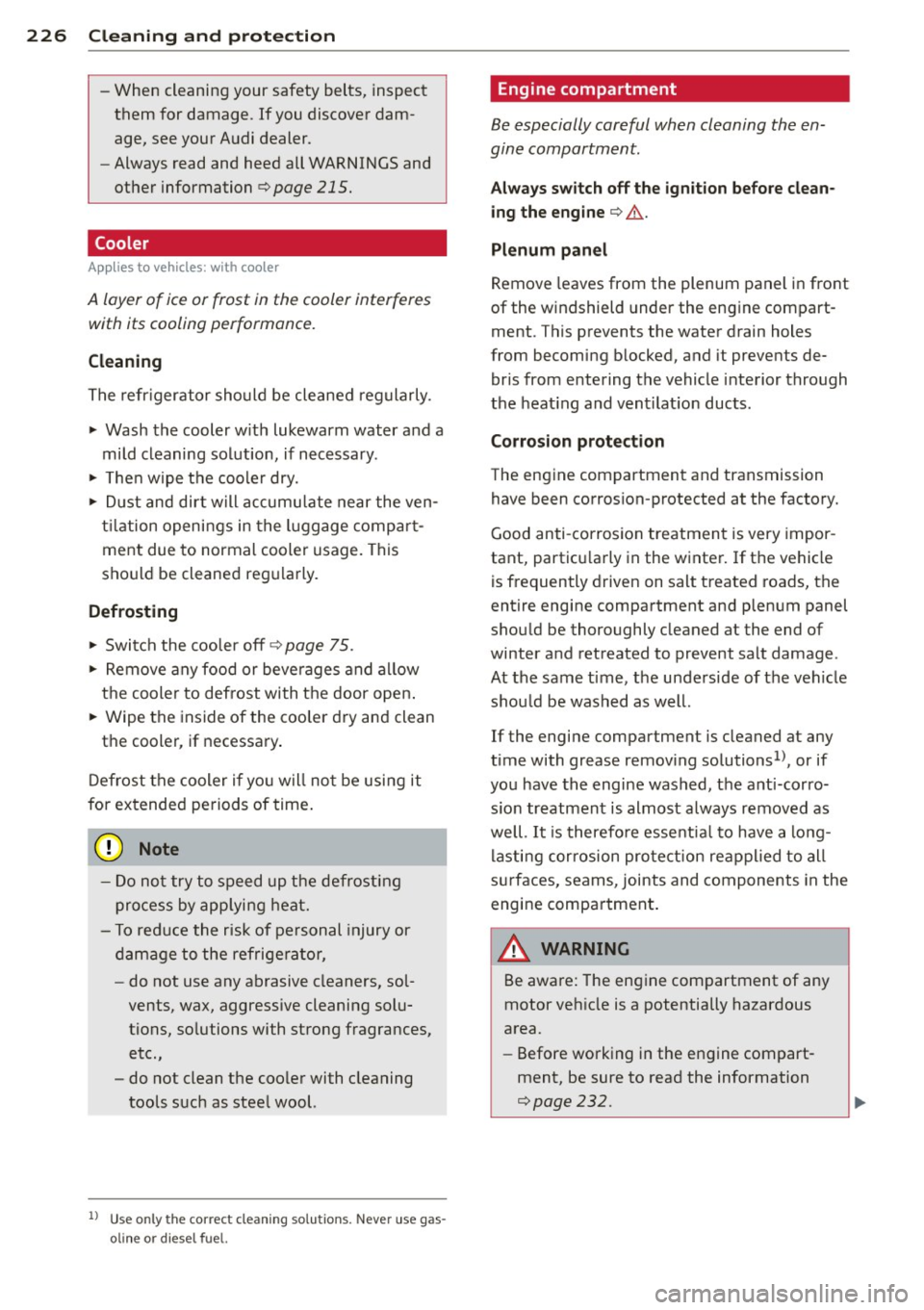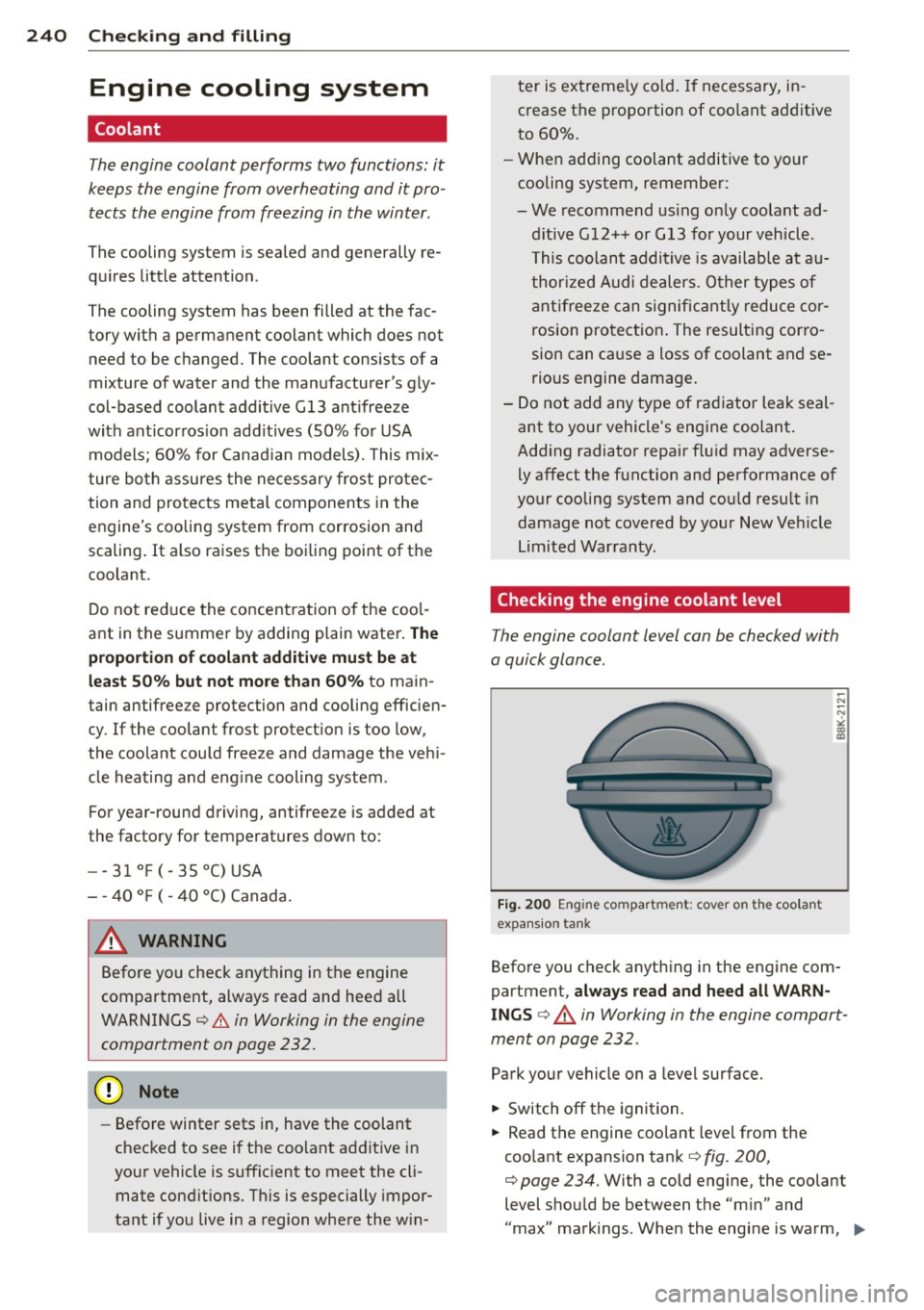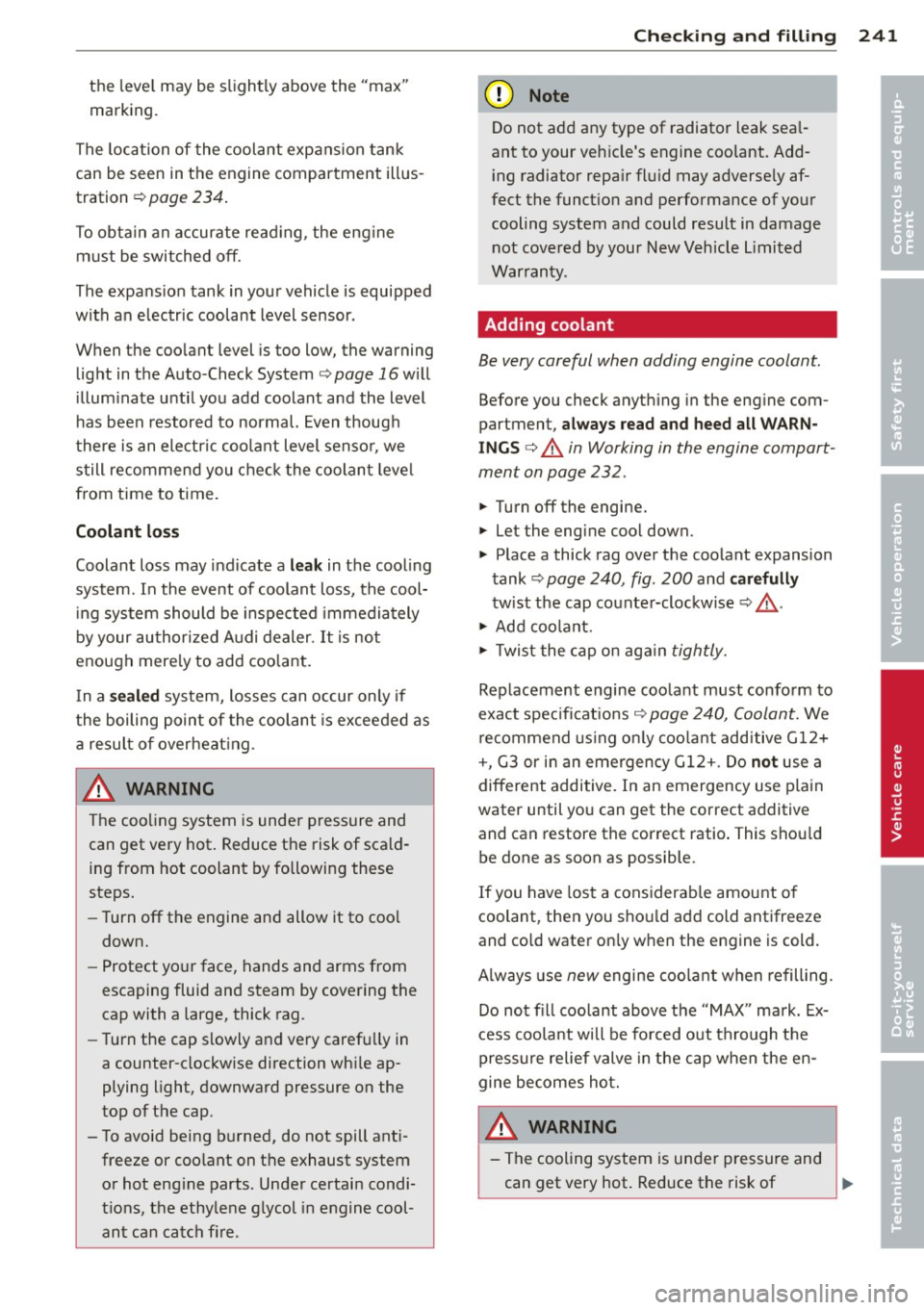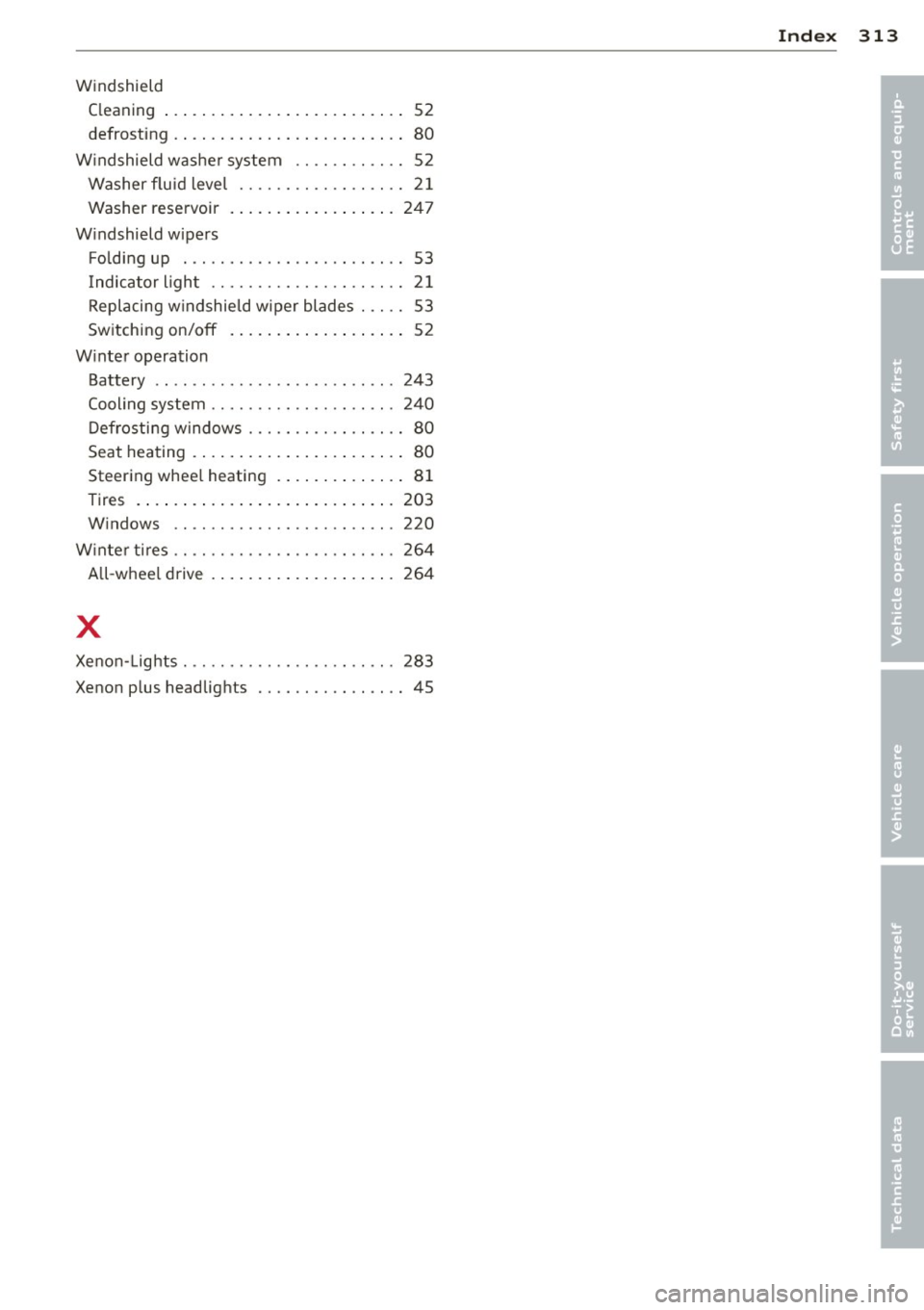cooling AUDI A8 2013 User Guide
[x] Cancel search | Manufacturer: AUDI, Model Year: 2013, Model line: A8, Model: AUDI A8 2013Pages: 318, PDF Size: 79.34 MB
Page 228 of 318

226 Cleaning and protec tio n
-When cleaning your safety belts, inspect
them for damage.
If you discover dam
age, see your Audi dealer .
- Always read and heed all WARNINGS and
other information
¢ page 215.
Cooler
Applies to vehicles: with cooler
A layer of ice or frost in the cooler interferes
with its cooling performance.
Cl ean ing
The refr igerator sho uld be cleaned regularly.
.. Wash the cooler w ith lukewarm water and a
mild cleaning solut ion, if necessary .
.. The n wipe the cooler dry.
.. Dust and dirt will accumu late near the ven
t il ation openings in the luggage compar t
ment due to normal cooler usage. This
should be cleaned regularly.
Defrost ing
.. Swi tch the cooler off¢ page 75.
.. Remove any food or beve rages and al low
the cooler to defrost with the door open .
.. Wipe the inside of the cooler dry and clean
the cooler , if necessary .
Defrost the cooler if yo u will not be using it
for extended periods of time .
@ Note
-Do not try to speed up the defrost ing
process by applying heat.
- To reduce the risk of personal injury or
damage to the refrigera to r,
- do not use any abrasive cleaners, sol
vents, wax, aggressive cleaning solu
tions, so lutions with strong fragrances,
etc.,
- do not clean the coo ler with cleaning
tools such as stee l wool.
1l Use o nly th e co rrect cle anin g so lu ti on s. Never use gas
o lin e or d ie se l fu el.
Engine compartment
Be especially careful when cleaning the en
gine compartment.
Always switch off the ign it ion before cle an
i ng th e eng in e¢ .&. .
Plenum panel
Remove leaves from the plenum panel i n front
of the windshield under the engine compart
ment. This prevents the water drain holes
from becoming b locked, and it prevents de
bris from entering the vehicle interior through
the heat ing and ventilat ion ducts .
Corrosi on protect ion
The engine compartment and transmission
have been corrosion-protected at the factory .
Good anti-corrosion treatment is very impor
tant, partic ularly in the winter.
If the vehicle
is frequently driven on salt treated roads, the
entire engine compartment and plenum panel
shou ld be thoroughly cleaned at the end of
winter and retreated to prevent salt damage .
At the same time, the underside of t he veh icle
shou ld be washed as well.
If the engine compartment is cleaned at any
time with grease remov ing solutions
1>, or if
you have the engine washed, the anti-corro
s ion treatment is almost a lways removed as
well . It is therefo re esse ntia l to have a lo ng
lasti ng corrosion pro te ct ion reapplied to all
surfaces, seams, joints and components in the
engine compartment .
A WARNING
Be aware: The engine compartment of any
motor vehicle is a potentially hazardous
area.
- Before working in the engine compart
ment, be sure to read the information
¢page 232.
Page 242 of 318

240 Checking and filling
Engine cooling system
Coolant
The engine coolant performs two functions: it
keeps the engine from overheating and it pro
tects the engine from freezing in the winter .
The cooling system is sealed and generally re
quires little attention.
The cooling system has been filled at the fac
tory with a permanent coolant which does not need to be changed. The coolant consists of a
mixture of water and the manufacturer's gly
col-based coolant additive Gl3 ant ifreeze
with anticorros ion add itives (50% for USA
models; 60% for Canadian models). This mix
ture both assures the necessary frost protec
tion and protects metal components in the
engine's cooling system from corrosion and
scaling. It also raises the boiling point of the
coolant.
Do not reduce the concentration of the coo l
ant in the summer by adding plain water .
The
proportion of coolant additive must be at
least 50% but not more than 60%
to main
tain antifree ze protection and cooling efficien
cy. If the coolant frost protection is too low,
the coolant could freeze and damage the veh i
cle heating and engine cooling system .
For year-round driving, antifree ze is added at
the factory for temperatures down to:
- -31°F(-35°C)USA
- - 40 °F ( - 40 °C) Canada.
A WARNING
Before you check anything in the engine
compartment, always read and heed all
WARNINGS
c:> &. in Working in the engine
compartment on page 232.
- Before winter sets in, have the coolant
checked to see if the coolant additive in
your vehicle is sufficient to meet the cli
mate conditions. This is especially impor
tant if you live in a region where the w in- ter
is extreme ly cold . If necessary, in
crease the proportion of coolant additive
to 60%.
- When adding coolant additive to your
cooling system, remember:
- We recommend using only coolant ad
ditive Gl2++ or Gl3 for your vehicle .
This coolant additive is available at au
thorized Audi dealers. Other types of
antifreeze can significantly reduce cor
rosion protection. The resulting corro
sion can ca use a loss of coolant and se
rious engine damage.
- Do not add any type of radiator leak seal
ant to your vehicle's engine coolant .
Add ing radiator repair fluid may adverse
ly affect the function and performance of
your cooling system and could result in
damage not covered by your New Vehicle
Limited Warranty.
Checking the engine coolant level
The engine coolant level can be checked with
a quick glance .
Fig. 200 Engin e compar tmen t: cover on t he coolant
expansio n ta nk
Before you check anything in the engine com
partment,
always read and heed all WARN
INGS c:> &. in Working in the engine compart
ment on page 232 .
Park your vehicle on a level surface .
.,. Switch off the ignition.
.,. Read the engine coolant level from the
coo lant expansion tank
c:> fig. 200,
c:> page 234. With a cold engine, the coolant
level should be between the "min" and
"max" markings. When the engine is warm, ..,
Page 243 of 318

the level may be slightly above the "max"
marking .
The location of the coolant expansion tank
can be seen in the engine compartment illus
tration ¢
page 234.
To obtain an accurate reading, the engine
must be switched
off.
The expansion tank in your vehicle is equipped
with an electric coolant level sensor.
When the coolant level is too low, the warning
light in the Auto-Check System
¢page 16will
illuminate until you add coolant and the level
has been restored to normal. Even though
there is an electric coolant level sensor , we
still recommend you check the coolant level
from time to time.
Coolant loss
Coolant loss may indicate a leak in the cooling
system. In the event of coolant loss, the cool
ing system should be inspected immediately
by your authorized Audi dealer.
It is not
enough merely to add coolant.
In a
sealed system, losses can occur only if
the boiling point of the coolant is exceeded as
a result of overheating.
& WARNING
The cooling system is under pressure and
can get very hot. Reduce the risk of scald
ing from hot coolant by following these
steps.
- Turn
off the engine and allow it to cool
down.
- Protect your face, hands and arms from
escaping fluid and steam by covering the
cap with a large, thick rag.
- Turn the cap slowly and very carefully in
a counter-clockwise direction while ap
plying light, downward pressure on the
top of the cap.
- To avoid being burned, do not spill anti freeze or coolant on the exhaust system or hot engine parts . Under certain condi
tions, the ethylene glycol in engine cool
ant can catch fire .
Checking and filling 241
@ Note
Do not add any type of radiator leak seal
ant to your vehicle's engine coolant. Add
ing radiator repair fluid may adversely af
fect the function and performance of your
cooling system and could result in damage not covered by your New Vehicle limited
Warranty .
Adding coolant
Be very careful when adding engine coolant.
Before you check anything in the engine com
partment,
always read and heed all WARN
INGS ¢ & in Working in the engine compart
ment on page 232 .
.,. Turn off the engine .
.,. let the engine cool down.
.,. Place a thick rag over the coolant expansion
tank ¢
page 240, fig . 200 and carefully
twist the cap counter-clockwise ¢&_ .
.,. Add coolant.
.,. Twist the cap on again
tightly.
Replacement engine coolant must conform to
exact specifications ¢
page 240, Coolant. We
recommend using only coolant additive G12+
+, G3 or in an emergency G12+. Do
not use a
different additive. In an emergency use plain
water until you can get the correct additive
and can restore the correct ratio. This should
be done as soon as possible.
If you have lost a considerable amount of
coolant , then you should add cold antifreeze
and cold water only when the engine is cold.
Always use
new engine coolant when refilling.
Do not fill coolant above the "MAX" mark. Ex
cess coolant will be forced out through the pressure relief valve in the cap when the en
gine becomes hot.
A WARNING
- The cooling system is under pressure and
can get very hot. Reduce the risk of
II-
•
•
Page 305 of 318

Important safety instructions for using
child safety seats . . . . . . . . . . . . . . . . . . 179
Important things to know when driving
with children ............ .... .. ... 176
Tether anchors ........... .... .. ... 193
T ether straps ............... ... ... 193
Child safety lock Rear doors (mechanical) ............. 40
Rear doors (power) ....... .. .. .. .. .. 40
Child safety seat Unused safety belts on the rear seat .. 181
Child safety seats ............. .... .. 182
Booster seats . . . . . . . . . . . . . . . . . . . . . 184
Convertible child seats .... .. .. .. .. . 183
Convertible locking retractor .. .. .. .. . 186
How do I properly install a child safety
seat in my vehicle? ................. 179
Infant seats . . . . . . . . . . . . . . . . . . . . . . 182
Installing .. ............. .... .. ... 186
Installing a child restraint using the
LATCH system . . . . . . . . . . . . . . . . . . . . . 192
LATCH system . . . . . . . . . . . . . . . . . . . . . 192
Lower anchorages ........... .... .. 190
Mounting and releasing the anchorage
hook .. .. .. .... ............. .. .. . 192
Safety instructions ........ .. .. .. .. . 179
Cleaning Matte finish paint ............ ... .. 218
Cleaning and protection ..... .. .. .. .. . 215
Alcantara (synthetic suede) . .. .. .. .. . 225
Cooler ... .. ................. .. ... 226
Engine compartment ........... .... 226
Exhaust tail pipes .... ..... .. .. .. .. . 222
Fabrics and fabric coverings .. .. .. .. . 222
I nstrument panel ......... .. .. .. .. . 223
I nterior .. .. ............. .... .. .. . 222
Leather .... ................ ... ... 224
MMI display/controls ......... ... .. . 222
Plastic and vinyl . . . . . . . . . . . . . . . . . . . 219
Plastic parts .. ........... .. .. .. ... 223
Safety belts ............. .... .. ... 225
trim strips ........... .... ... ... .. 220
Trim strips . ................ ... ... 219
Climate controls . . . . . . . . . . . . . . . . . . . . . 78
Clock . .. .. .. ................. .. .. .. 26
Index 303
Closing
Panoramic sunroof ................ .. 43
Slid ing/tilting sunroof ............... 42
Sun shade (panoramic sunroof) .... .. . 44
Cold tire inflation pressure ........ .... 253
Coming home . .. .. .. .. .. ...... ...... 47
Compact spare tire ................. . 272
Compartments .. .. ................. . 74
Compass in the mirror ............... . 55
Compliance ..... .... ............... 299
Consumer Information . . . . . . . . . . 142, 296
Consumption (fuel) ................. . 24
Contacting NHTSA .............. .. .. 142
Convenience key . . . . . . . . . . . . . . . . . . . . . 34
Starting the engine .. .... .. .... .... . 83
Stopping the eng ine (START ENGINE
STOP button) . . . . . . . . . . . . . . . . . . . . . . 84
Switching the ignition on ....... .. .. . 83
Unlocking and locking vehicle ....... .. 34
Convertible child safety seats . .... .. .. 183
Convertible locking retractor Activating . . . . . . . . . . . . . . . . . . . . . . . . 188
Deactivating . .. .. ................. 188
Using to secure a child safety seat 1.86, 188
Coolant
refer to Engine coolant ............ . 240
Cooler ..... .. .. .. .... ............. . 75
Cleaning .... .. .. ............... .. 226
Operation ......................... 75
Cooling mode (automatic climate control) 79
Cruise control Changing speed .. ............. .. .. . 91
Presetting your speed ............... 91
Switching off .. .. .. ..... ........... 91
Switching on . .. .. .. . .. .... ........ . 90
(upholder .... .. ...... ............. . 74
Curve light .. .. .. .. .. ............... 109
Cylinder on demand System ...... .. .. . 26
D
Data ........... .. .. . .............. 292
Data recorder . .. .. .. .. ........... .. 198
Date display ...... .. ..... ........... 26
Daytime running lights .............. .. 45
•
•
Page 315 of 318

Windshield Cleaning ... ..... ........ .. .. .. .... 52
defrosting .. ............. .. .. .. .. .. 80
Windshield washer system .. .. .. .. .. .. 52
Washer fluid level . . . . . . . . . . . . . . . . . . 21
Washer reservoir ............... .. . 247
Windshield wipers
Foldin g up . . . . . . . . . . . . . . . . . . . . . . . . 53
Ind icator light . . . . . . . . . . . . . . . . . . . . . 21
Replacing wind shie ld wiper blades . .. .. 53
Switching on/off . . . . . . . . . . . . . . . . . . . 52
Winter operation Batter y . . . . . . . . . . . . . . . . . . . . . . . . . . 243
Cooling system ............... .. .. . 240
D efrosting w indows ....... .. .. .. .. .. 80
Seat heating . . . . . . . . . . . . . . . . . . . . . . . 80
Steer ing whee l heating .......... .. .. 81
Tires . ..... .. .. ........... .. .. ... 203
Windows .. ............. .... .. ... 220
Winter tires .. ............. .... .. .. . 264
All-wheel drive ........... .. .. .. ... 264
X
Xenon-Lights . .. ........... .. .. .. ... 283
Xenon plus headlights ...... .. .. .. .. .. 45
Index 313
•
•